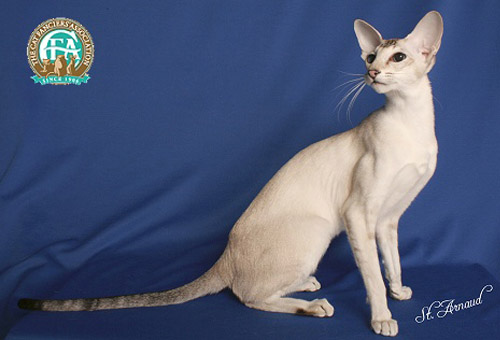


The Oriental has an equally colorful personality. They are closely linked to the people they claim as their own and desperately want to share their lives with you. In the busiest moments, your Oriental will find a way to interrupt your activities; a little nudge while you eat, a close examination of your tooth brush prior to use, or some help tying your shoes before you leave in the morning. It’s understood you’ll need help deciding which items to select from the refrigerator! In the calmest of times they’ll share the warmth of your lap, provide a comforting purr, and nuzzle your chin when you need it the most.  Pictured: Best of Breed GC, BW, NW KUAN JIN ZOE, Seal Lynx Point Pointed Oriental Shorthair Female Photo: © St. Arnaud They eagerly greet you at the door and tell you all about their day. If you're late, they will scold you and tell you how worried they were that you didn't call. Hide their feather on top of the refrigerator? Wrong! Curiosity and intelligence combine, providing them a means of finding anything and everything.
They have been known to open a drawer, or empty your purse to discover their favorite toy. It might be a pen or a crumpled up piece of paper that they can chase around the kitchen floor, it really doesn't matter. Give them the attention and affection they so desperately need, and they will do anything to please you. Ignore them, and they will droop with despair. These elegant, svelte cats remain playful, spirited and loyal well beyond their youth. From the tip of its nose to the end of its long, whippy tail, the Oriental is a study in sleek design. This elegant cat gracefully glides across the room on its tall, slender legs. The lines of its angular head flow into its large flaring ears, and are complimented by its almond shaped eyes. Don’t be fooled by the svelte, tubular body; these cats have surprising weight and muscle tone and are neither frail nor fragile.  Pictured: Second Best of Breed GC, BW, RW NOXX MARIO KEMPES OF PURRMATIX, Ebony Silver Tabby Oriental Longhair Male Photo: © Larry Johnson
Orientals represent a diverse group of cats that have their foundation in the Siamese breed. When the Oriental Shorthair was accepted for championship status in 1977 it rapidly became one of CFA’s most popular breeds. With the 1995 addition of the Oriental Longhair into this family of sleek, muscular felines the Oriental breed can provide a cat for just about anyone. With over 300 different colors and patterns to choose from, you’re guaranteed to find an Oriental that will tickle your fancy. Imagine a Siamese wearing a head to toe coat in white, red, cream, ebony, blue, chestnut, lavender, cinnamon or fawn. These are our solids. For a sparkling undercoat, stir in the silver gene (to all but the white), and you have a smoke Oriental. Perhaps, instead, you'd like the color restricted to the tips of the hair. For this, we have the shadeds to whet your appetite. Paint splashes of red and/or cream on any of these coats and you have a parti-color.
If you like stripes on the legs, tail and face, try a tabby in any of four different patterns: classic, mackerel, spotted, or ticked. Cross the patterns and colors together for a bit of variety, and 32 different combinations emerge…but we’re not through. Once again add a patch of red and/or cream and voilá…another 24 combinations, referred to as patched tabbies. Layer in the sparkle of that silver gene, and you’ve added yet again 56 more! (That’s 112 tabby combinations if you’ve been counting!) In 1995 Orientals added the bi-color pattern to their repertoire. With the clear white underside, legs, chest and inverted V on the face, these distinctly marked members of this breed have already developed a following of devoted fans.  Pictured: Third Best of Breed GC, RW CLOWNTOWN'S DOUBLE YOUR FUN, Calico Oriental Longhair Female Photo: © Chanan Finally, breeders dedicated to developing another major addition to the breed added the longhair variety, paralleling their Balinese and Javanese counterparts. These beautiful felines carry the same graceful bodies with the addition of a silky long coat, goatee, and long plumed tail. For the shorthair Oriental, the coat appears painted on, it is soft and satin like to the touch, and their long whippy tail seems to go on forever.
Pricing on Orientals usually depends on type, applicable markings and bloodlines distinguished by Grand Champion (GC), National Regional winning parentage (NW or RW) or of Distinguished Merit parentage (DM). The DM title is achieved by the dam (mother) having produced five CFA grand champion/premier (alter) or DM offspring, or sire (father) having produced fifteen CFA grand champion/premier or DM offspring. Usually breeders make kittens available between twelve and sixteen weeks of age. After twelve weeks, kittens have had their basic inoculations and developed the physical and social stability needed for a new environment, showing, or being transported by air. Keeping such a rare treasure indoors, neutering or spaying and providing acceptable surfaces (e.g. scratching posts) for the natural behavior of scratching (CFA disapproves of declawing or tendonectomy surgery) are essential elements for maintaining a healthy, long and joyful life. There are CFA clubs devoted to the promotion, protection and preservation of the Oriental breed. For more information, please send inquiries to CFA at cfa@cfa.org. Text: Bob Agresta and Joann Kultala Last Updated: Tuesday, July 27, 2010
|
|||||||||||